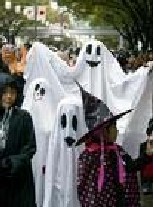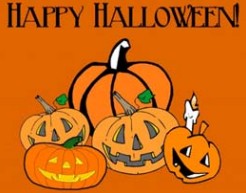Hallowe’en
到神秘的鬼屋去探险,拜访那些可爱的精灵鬼怪,听听那些古老的或新鲜的鬼故事,学学做个吓人的南瓜灯笼,咬一口吊在空中的苹果。快乐来得就这么简单,这就是万圣节!

Hallowe’en is a popular festival in many countries all over the world, and every year it seems to get bigger.
It’s getting dark earlier and it’s starting to get cold. Christmas is still a long way away. We need something to cheer us up and take our minds of the fact that winter is nearly here. See how much you know about the traditional festival of Hallowe’en.
The origins of the name
The festival of Hallowe’en has its roots in Celtic and Roman traditions. Over 2,000 years ago the Celts in Britain, Ireland and parts of France celebrated Samhain to mark the beginning of winter. When the Romans invaded, they merged this with Feralia, their celebration of the passing of the dead. As Christianity spread, the Church tried to replace these pagan feasts with official Church holy days. One of these was November 1. It was called “All Hallows”, and October 31 was known as “All Hallows’ Eve”, and then Hallowe’en.
Hallowe’en traditions
In the past there was a tradition called “souling”. Poor people went around houses asking for food. In exchange, they promised to say prayers for the dead. People no longer go souling, but the habit has been transformed into a modern Hallowe’en game for children in America, who dress up as ghosts, witches and monsters and go around people’s houses.
Witches
Hallowe’en wouldn’t be fun without witches. Witches have always been part of popular folklore. Shakespeare’s play “Macbeth” opens with three witches. A witch was someone — usually a woman— who had special powers and had dealings with the devil. The American town, Salem, is famous for the “witchcraft trials”, which took place there in 1692.
Pumpkins
 |
The pumpkin has become a symbol of Hallowe’en. People empty a pumpkin, cut a face into the side, and put a candle inside to make a lamp. It’s known as a Jack O’ Lantern, from a story about a man called Jack, who made a deal with the devil.
Animals
Black cats, frogs, mice and spiders are just some of the animals associated with Hallowe’en. Generally, the more unpleasant the animal, the stronger the Hallowe’en connection. Nocturnal animals like bats are particular favourites, and if, as is the case with vampire bats, they like
drinking blood, they are high on the Hallowe’en list.
[注释]:
Hallowe’en: 万圣节前夕(10 月31 日夜)
Celtic and Roman traditions: 在古代,凯尔特人要在夏末举行仪式感谢上苍和太阳的恩惠。
当时的占卜者点燃灯笼并施巫术以驱赶据说在四周游荡的妖魔鬼怪。后来,凯尔特人的
10 月31 日与罗马人用果仁和苹果来庆祝的丰收节融合了。
Samhain:也就是古代凯尔特人庆祝的节日(10 月31 日),意为“夏末”
merge: to blend together, especially in gradual stages 融合
Feralia:古代的一个宗教节日
pagan: one who has no religion 异教徒
witch: a woman popularly believed to have supernatural powers and practice sorcery, and often
believed to be aided by spirits or a familiar 巫师,女巫
monster: 怪物,妖怪
folklore: the traditional beliefs, myths, tales, and practices of a people, transmitted orally 民间
传说
Macbeth: king of Scotland 麦克白 (莎士比亚悲剧《麦克白》中的主人公)
Salem: 塞勒姆,美国东北部城市,因1692 巫师审判及N.霍桑的“匕墙之房”而著名
pumpkin: a coarse, trailing vine (Cucurbita pepo) widely cultivated for its fruit 南瓜
spider: 蜘蛛
nocturnal: of, relating to, or occurring in the night 夜的,夜曲的
vampire: a reanimated corpse that is believed to rise from the grave at night to suck the blood of
sleeping people 吸血鬼
万圣节期间,许多公共场所乃至居家院落,都会布置上很多装饰,诸如各式鬼怪、南瓜灯、黑猫以及巫婆的扫帚之类。孩子们则会穿上不同的万圣节服装,拎着南瓜灯挨家挨户地敲门并说“trick or treat”,向主人讨糖(或其他小东西)。给的话就是“treat”(请客),不给的话他们就会用“trick”(砸玻璃、涂门啊之类恶作剧)来捣乱。







